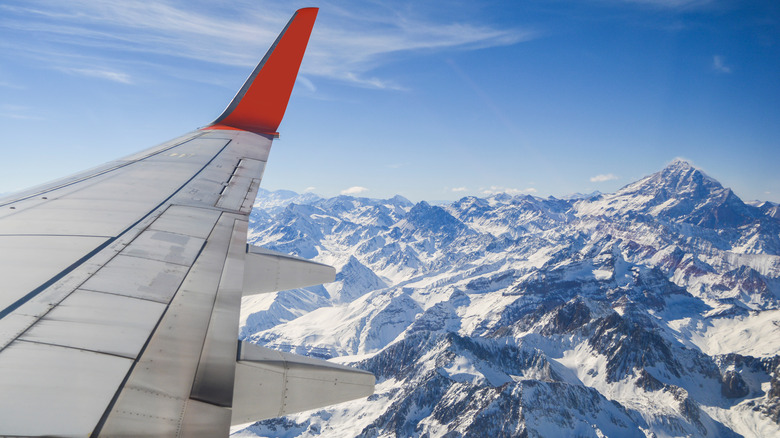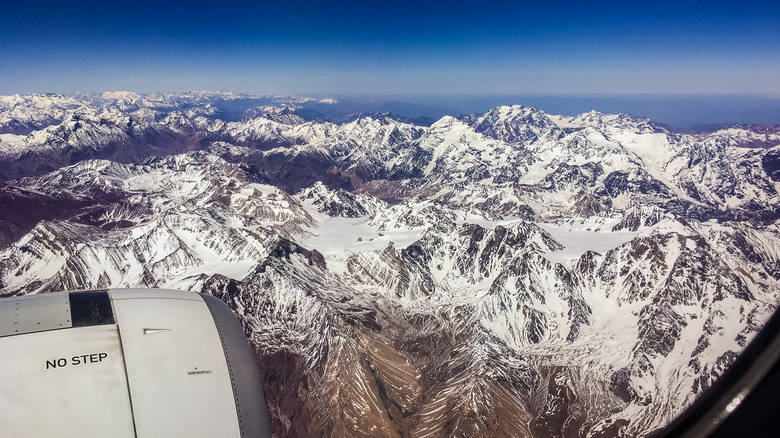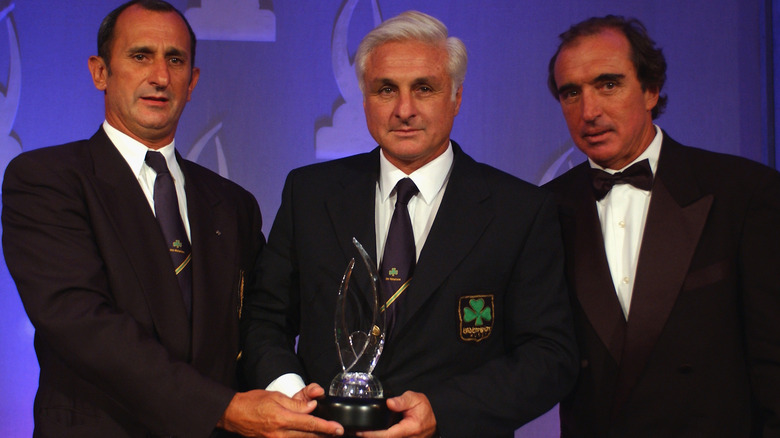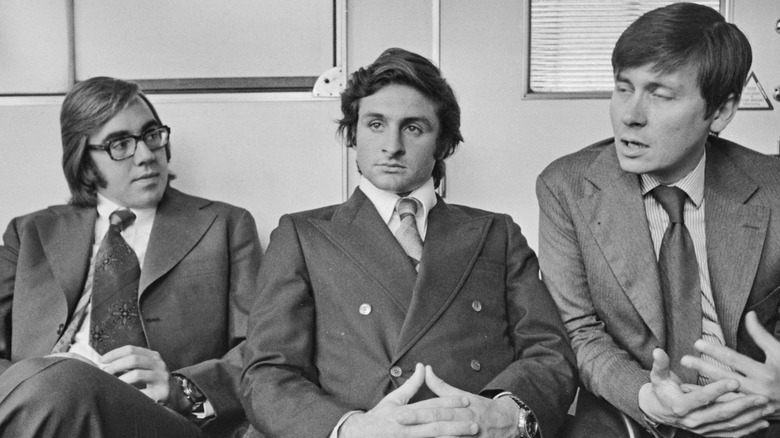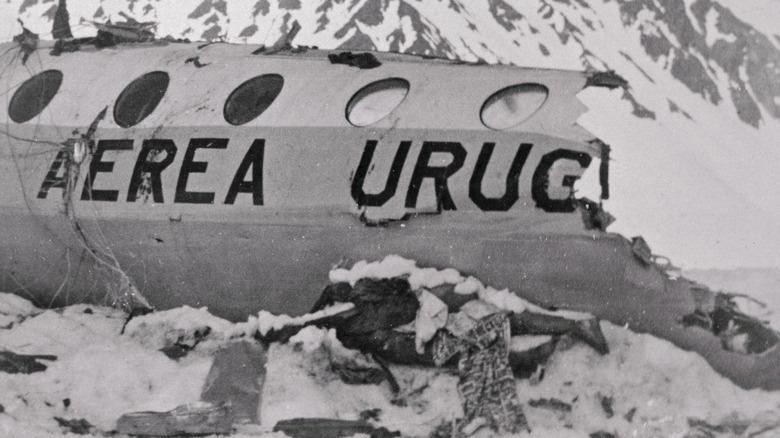The Tragic Truth Behind The Andes Plane Crash
On October 13, 1972, the Uruguayan Air Force Flight 571 crashed in Argentina, and the subsequent days of survival would impress and disturb people worldwide. The flight was charted by an amateur Uruguayan rugby team that was traveling to Santiago, Chile, and there were a total of 45 people on the flight. But by the time they were found two months later, only 16 were alive (via Britannica).
Nearly one hour after the plane took off, the pilot contacted air controllers saying he was flying over Curico, Chile, and they were preparing to land. However, he was still in the Andes, and shortly after that, air controllers lost contact with the plane. The controllers started to look for the missing aircraft, but it was clear they had the wrong location. The rescue mission expanded the search area, but the mountains were covered with snow, making the task very difficult. After eight days, the operation came to an end after the team determined that no survivors could have survived the extreme weather conditions.
The survivors heard the news on the radio. "We felt abandoned, and we felt so angry with everybody, with – even with our families, with the world, with God, with nature, with everything," said Eduardo Strauch, one of the survivors (via NPR). "We were absolutely angry. But very fast, very quick, we realized that the only way to get out would be by doing it by ourselves."
The survivors had to improvise
When the plane crashed into the snowy peaks of the Andes Mountains, 33 people survived and 12 died. Several people were injured, and after the first night stranded in the mountains, five other people died. According to The New Zealand Herald, the survivors created a shelter using parts of the airplane, and the group soon realized they had to be organized and improvise to survive. They melted snow to get water, filled the rugby socks with meat when they went for a trek, and used the kitchen's insulation as a sleeping bag.
Roberto Canessa, a survivor who was a 19-year-old medical student during the ordeal, was responsible for taking care of injuries and carting the dead bodies, per National Geographic. "We needed blankets, so we skinned the seats of the plane, which contained a wool fabric," he said. "We put all the suitcases at the back of the fuselage to keep out the weather. We made sunglasses from the plastic screen in the pilot's cabin. We used the bottom of the seats for snowshoes and built hammocks for the people with broken legs." He would go on to become one of the most famous doctors from Uruguay and write books about his experience.
The most difficult decision
During one week, the group burned through the supplies in the airplane, which were mostly candies and wine. According to Eduardo Strauch, when their food supply ran dry, they tried to eat the leather from the shoes and belts. But the plan didn't work out, and they had to find something to eat, NPR reported. After a lengthy discussion, the group decided they had to consume the corpses to survive.
"I was convinced that it was the only way to live," Strauch said. "I want to live. I was very young. And at the beginning, when I realized it was what I was going to do, my mind and my conscience was okay. But physically, it was very difficult to get it in the first day. Even to us, they were very small pieces of frozen meat. It doesn't taste anything. I get used to. And at the end — absolutely disconnected with the origin of that food."
Roberto Canessa has also been open about his experience. "My main issue was that I was invading the privacy of my friends: Raping their dignity by invading their bodies," he said, per National Geographic. "But then I thought, if I were killed, I would feel proud that my body could be used for others to survive."
They received help in Chile
Despite their new cannibalistic plan for sustenance, people were still dying every week. And on October 1972, the most dramatic moment of the ordeal happened when an avalanche killed eight more people and covered part of the plane they were using as a shelter, per Britannica. Afterward, the group began to make expeditions to look for help. On December 12, there were only 16 survivors when three of them — Roberto Canessa, Fernando "Nando" Parrado, and Antonio "Tintin" Vizintín — decided to go on a new trek to Chile. Eventually, Vizintín returned so the remaining two would have more rations.
"Nando and I became like one person," Canessa told Time about the journey. "When he was cold, I was cold. I would put my arm around his back because his jacket was quite short and his kidneys were freezing. We were two into one walking together. Every step was a step less and every step we were getting closer. So as long as we could take steps, we would reach the valleys of Chile."
The pair reached Los Maitenes — a village in Chile — after eight days and were able to flag a man on horseback for help. The rescue came two days later.
14 people were rescued
The team first rescued six survivors — the other eight had to wait until the next day due to the bad weather. Alipio Vera, then a reporter from Televisión Nacional de Chile (TVN), was one of the people who arrived at the scene. "They were very weak, their voices were barely audible ... it was incredible, to see people that were rugby players, who were pretty strong, now they were almost skeletons," she told ABC News.
Wilma Koch, the nurse who attended Nando Parrado and Roberto Canessa, said that Parrado looked better than Canessa. But this apparently didn't last long, as in December 2023, Parrado told The Guardian that the rescue team originally thought he was dead. "They left me in the snow," he said. "They didn't give me any water. They didn't hydrate me." Doctors later told him that extreme temperatures and dehydration likely helped him live by curbing the brain swelling he sustained from a head injury.
As of 2024, 12 of the 14 rescued survivors were still alive, the Daily Mail reported.
Aftermath
The rescue received lots of media attention, especially when people found out the survivors had to eat each others' bodies to remain alive. The story has inspired many books and movies, including 1993's "Alive," based on the book "Alive: The Story of the Andes Survivors." Over 50 years after the accident, the survivors are still making the headlines by sharing their unbelievable experiences in interviews and literature.
Parrado (above) spent 26 years before speaking to the media about the terrifying ordeal. "Today, I would never go near that aeroplane," he told The Guardian in December 2023, not long after the October release of Netflix's "Society of the Snow," a fictional portrayal of the events. "A Fairchild FH-227D, very underpowered engines, full of people, completely loaded, flying over the highest mountains in South America, in bad weather. I mean, no way."
Other survivors have also gone on to live successful lives, the Daily Mail reported. As of 2024, Fito Strauch worked in agriculture, Carlos Páez Rodríguez owned a public relations firm, and José Pedro Algorta had a master's degree in business administration.
